On the history trail in Rapallo with David Roberts
Due to the vagaries of travel in the age of COVID, the Italian end of Roberts Publications has been on "staycation" ( awful word I know) in Italy. To avoid airports, queues and son, I took the train to Rapallo in Liguria , which is about three hours from Milan ( depending on whether you have to change trains or not ). Rapallo is a charming seaside town on the Gulf of Tigullio. It makes a nice base to explore the coast of Liguria. The upmarket village of Portofino is about 8km walk from Rapallo, This is either on pavements, but after Santa Margherita, there is a specially constructed boardwalk, which has been attached to the side of the existing road , and which separates the walker from the traffic on the road. It is an extremely pleasant walk.
Anyway we are not here to do a travel blog, but the walk between Rapallo and Santa Margherita Liguria passes by three buildings of historical significance for the conferences which took place in them. Now when they did O-level history the proper way back in the 1970s, the Joint Matriculation Board syllabus covered Europe from 1900 to 1945. As part of that we had to learn and memorize the dates and significance of all those inter-war conferences which paved way the way towards the events of 1939. Al those treaties signed in Paris suburbs, St German, Neuilly and Sevres and that later ones in upmarket European resorts. Rapallo, Locarno, Stresa and Lausanne. So Rapallo is the city of two Peace Treaties, its welcome sign says so. It also turned put to be significant for the other researches I had been dong on the British Divisions which went to Italy to prevent the Italian front collapsing after the rout at Caporetto in October 1917.
The Rapallo Conference 1917 The first building which we come to on the road out Rapallo is the Hotel Excelsior, formerly the New Kursaal Hotel. This was the site of the Allied Conference in November 1917, at which the British and French agreed the support that they would be giving to the Italians following the disaster at Caporetto and established the Inter- Allied Supreme War Council. The original Kursaal Rapallo opened as a Casino on 1 January 1901 and was soon rivalling the Casinos of the French Riviera for the gamblers of early 20th Century Europe. So popular did the Kursaal Casino become, that they constructed a new hotel the New Kursaal hotel directly connected to the Casino and with its own bathing station in the bay. At the time the new hotel was the ultimate in luxury designed by the Lausanne architect Henry Verrey an executed by the Italian engineer Enrico Macchiavello. The 1924 Blue Guide to northern Italy, describes the hotel as having 220 beds “ in a fine situation and sharing a park with the casino”. The casino also offered as well as gaming, tennis courts, restaurants concert hall and an ice rink .
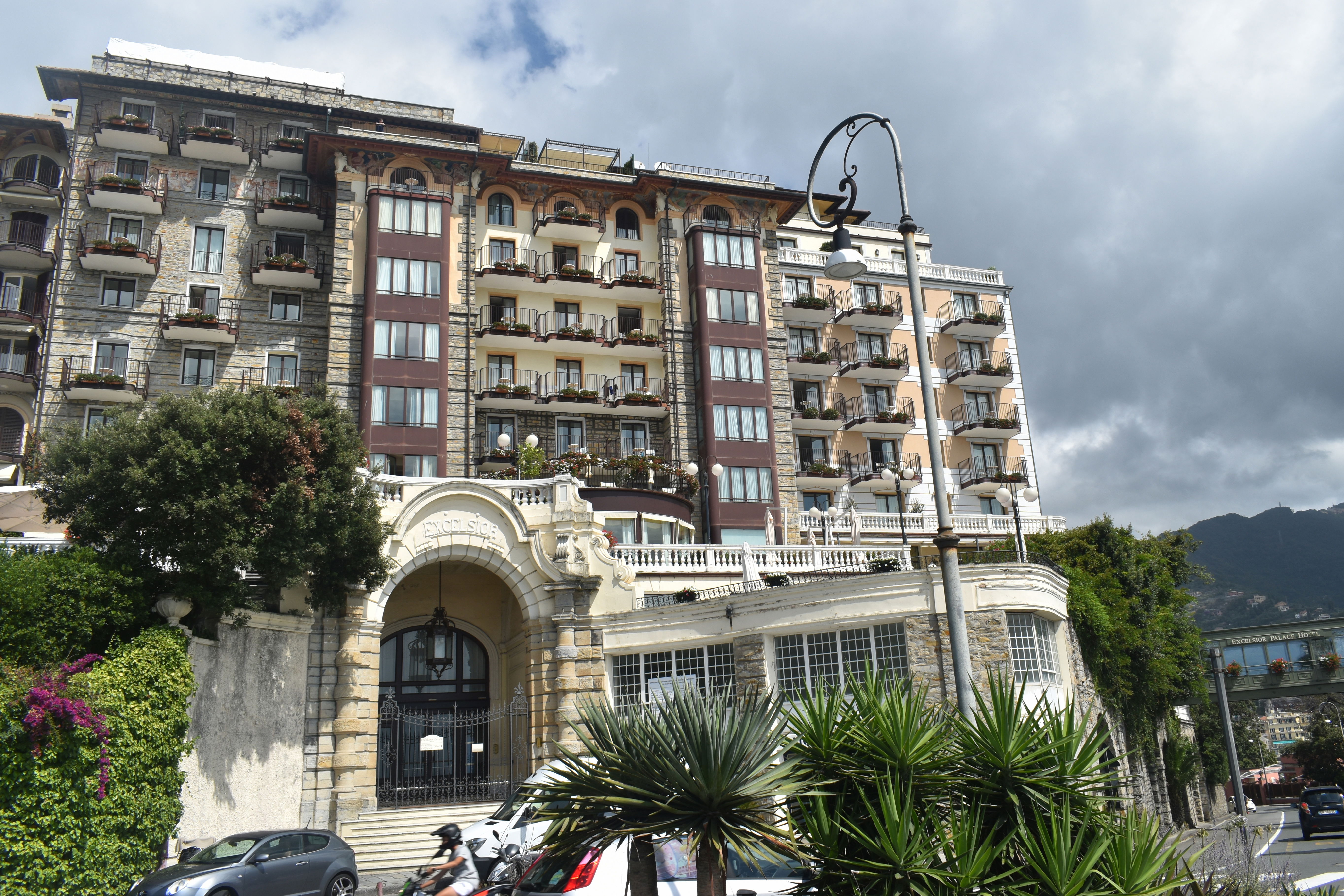
The Excelsior Place Hotel ( formerly the New Kursaal Hotel) Rapallo
On 30 October 1917, the French Minister, Monsieur Painleve visited London to discuss the military assistance to be given to Italy. The British Prime minister, Lloyd George raised the question of setting up a Supreme War Council. Given the difficulties on the Italian Front it was arranged that a conference would be held in Rapallo, Italy. The British delegation which set off for Rapallo consisted of Lloyd George, General Smuts from South Africa, Lieutenant-General Sir Henry Wilson, and Maurice Hankey. General William Robertson, the CIGS travelled up from Rome, where he had been in conference with the French General Foch and Italian minister, previously the two Generals had been to Treviso with the Italian Command Supremo, so they had done a fair bit of Italian travel in the previous few days
According to Lloyd George’s account as the British headed down to Italy by train from Paris towards the Mon Cenis tunnel, they passed trainload after trainload of French guns and cheerful French soldiers already heading for the Italian Front. On the other hand the British noticed that “At very wayside station we witnessed dejected fragments of the shattered Italian divisions many without rifles” . Once they got past Turin , and to the cost in Liguria they also began to see British reinforcements who had gone by train down the Rhone valley and were now heading on foot or in trucks along the French and Italian Riviera. This is a bit odd and possibly written after the event, since the British divisions did not start entraining in France until the 6th or 7th November and could not have got to the south of France by then. At the most some advance parties of around100 men and some transport units had set off earlier than that. The French divisions had started out for Italy, a bit earlier with XXXI Corps entraining on 31st October, they took the Paris -Modane- Mon Cenis route, so quite probably they did pass the British visitors.
The conference convened at 7pm on the evening of 5 November at the New Kursaal Hotel , the British were greeted by their Italian hosts, Signor Orlando, the Prime Minister; Baron Sonnino, the Minister of Foreign Affairs; General Alfieri, the Minister of War and Genera Carlo Porro, the Deputy Chief of General Staff. Most of the Italians only been in post since the 30 October, when the previous government resigned after the shock of Caporetto. In his memoirs, Lloyd George is impressed by Orlando and Sonnino and less than impressed by General Porro
“I knew nothing of his qualifications as a soldier, but he made the poorest impression on every mind at that conference. He presented a very inadequate account of the situation. He seemed to be ignorant of the most salient facts of the rout. He could tell us nothing that would enable us to form any true estimate of the military position of the Italian Army. He was the most unhelpful ingredient in that conference except in so far as his futility gave us at least one important clue to the disaster. He seemed to lack knowledge, energy and zeal for the discharge of his important duties and when we saw and heard him, we were not in the least surprised at the report given us by General Foch and Sir William Robertson of the chaos and confusion at Italian Headquarters. “
Basically Porro, seems to have spent his whole military career, either lecturing on military matters, writing books about geography, or serving on the general staff. Shall we say his active military service was limited. As Cadorna’s deputy, he held the second highest role in the Italian Army- being known as Cadorna’s more affable alter ego, Cadorna was away at the front and left Porro with the unenviable task of explaining to the British and French, just what the Italians were trying to stem their collapse. At the conference on November 5th, General Foch reported that the 2nd Italian Army was absolutely broken, but the 1st, 3rd and 4th Armies remained intact. It was subsequently reported by Signor Orlando that the 2nd Italian Army was the most important of their four Armies. General Foch proceeded to report that the;
“Armies still numbered some seven hundred thousand men and ought easily to be able to hold the shorter line of the Piave. The necessary condition, however, was that the Higher Command should be capable of issuing proper orders to the subordinate commanders. His impression was that the Higher Command was at present characterised by inertia. Orders were given, but no one saw that they were carried out. In fact, there was practically no Higher Command. “
The Italians were insisting on not less than fifteen British and French Divisions, which should be transported as rapidly as possible to Italy and concentrated in positions where they could be moved to the various threatened points. The Italian Government asked the Allies to consider that, to save the situation, it was not sufficient merely to render some assistance, but essential that that assistance should be adequate. Lloyd George stressed that the Allies were bound to do all in their power to assist their ally, Italy, in her difficulties, since it was the obvious interest of Britain and France to do all in their power to keep Italy in the War, even though her strength was employed more against Austria than against Germany. The British and French were committed to sending eight divisions and preferred to leave it at that. According to Lloyd George
“France had already sent out four of her very best divisions, most of which were already in Italy. We also were sending two of our best divisions. We intended to send two more divisions, which would make a total of eight British and French divisions in as short a time as the railways would permit their transport. I laid stress on the fact that these eight divisions were about the best in the British and French Armies. “
Discussions, then turned to the question of leadership, more specifically Italian military leadership. Lloyd George was convinced that it was useless to pour troops into Italy unless we were assured of efficient leadership of the Italian Army. Otherwise, the British and French divisions might find themselves left in the lurch As Lloyd George recalled in his memoirs.
“ Our information, however, was that the General Headquarters had been in a worse panic than the troops and had lost control of the situation. When we sent troops, we should be glad to entrust them to the gallantry of the Italian Army, and in that respect our confidence was not in the slightest degree impaired by recent events; but frankly speaking, we could not trust them to the present High Command.”
The conference at the Excelsior continued throughout the 6th and 7th November, On the evening of the 7th , the British and French delegations left Rapallo for Peschiera del Garda , where they had an appointment with the Italian King for the following morning. At that meeting Lloyd George set out the Allied view, regarding the unsatisfactory performance of the Italian High Command and the need for change.
On 9 November, Genera Cadorna was dismissed, and General Diaz took over. General Porro, who had substituted for Cadorna at Rapallo was dismissed the same day. By that time the British 23rd Division was entraining at St Omer. Together with units of the Royal Flying Corps and further French Divisions were also on the move. In the end the Italians stabilized their Front along the Piave and it turned out that not all the British and French Divisions were necessary, but it seemed a pretty close run thing at the time
Rapallo lost its casino licence to the rival Italian resort of San Remo, but the Excelsior Place remains, now much expanded and still dominating the bay of Rapallo from its position on the Ciappadea Cliff. The beach club, now has an infinity pool with spectacular view over the Bay of Tigullio towards Portofino, it must be one of the finest views from a swimming pool anywhere. It is strange to think that where rich Italians are now enjoying the sun, that a hundred years earlier the fate of Italy and the possible outcome of the entire First World War was being decided on that spot.
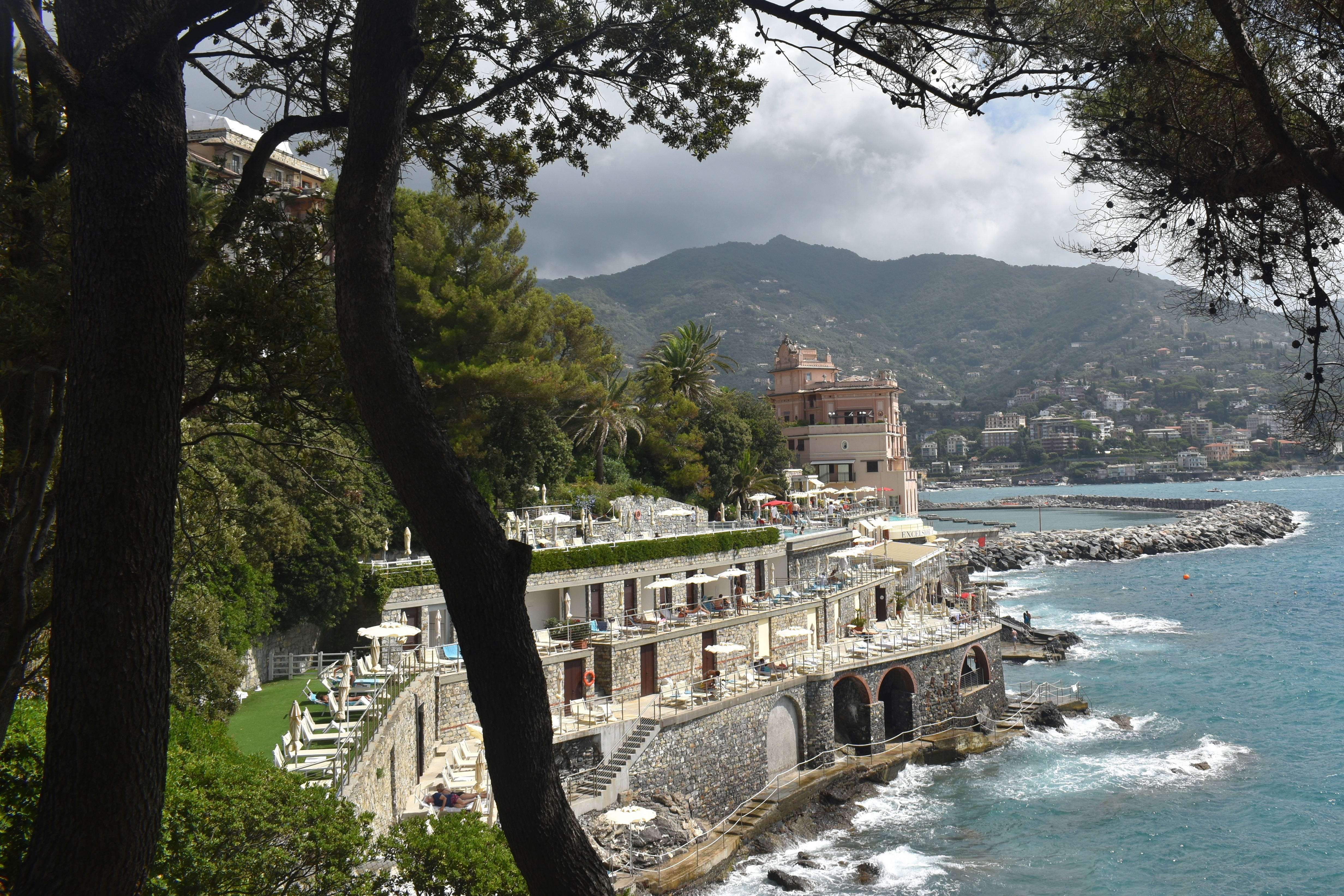
The bathing establishment at the Excelsior Palace with a view of the old Kursaal
The Treaty of Rapallo (1922)
After the war, came the peace and Rapallo was notable for two Post-War peace treaties. Leaving the Hotel Excelsior Palace , the coastal walk passes through the small beach resort of San Michele Pagano and then the road starts to climb again towards Santa Margherita, on reaching the brow of the hill, one can see the next Rapallo conference venue, the imposing white place of the Hotel Imperiale., where the Treaty of Rapallo between Germany and the Soviet Union was signed in 1922. According to the Hotel’s website it was originally a Liberty Style villa constructed for the Costa family , a noble family originating in Corsica. In 1905, it became a hotel and previously hosted Royal Guests , including Queen Elena of Savoy and literary and artistic figures, such as the actress Eleonora Duse and the author Pirandello. The Blue Guide for 1924 says it had 180 rooms and a fine southern exposure. I did not go into the hotel to try and photograph the Treaty Room, but you can see a nice photo on their website.
https://www.imperialepalacehotel.it/hotel-di-lusso-baia-portofino/storia
If you want to see how it looked in the1922, the following site has a good photo from 1910. https://www.historichotelsthenandnow.com/imperialepalacestmargheritaligure.html
The road is a lot busier these days and has obviously been widened, but the hotel itself looks fairly similar.
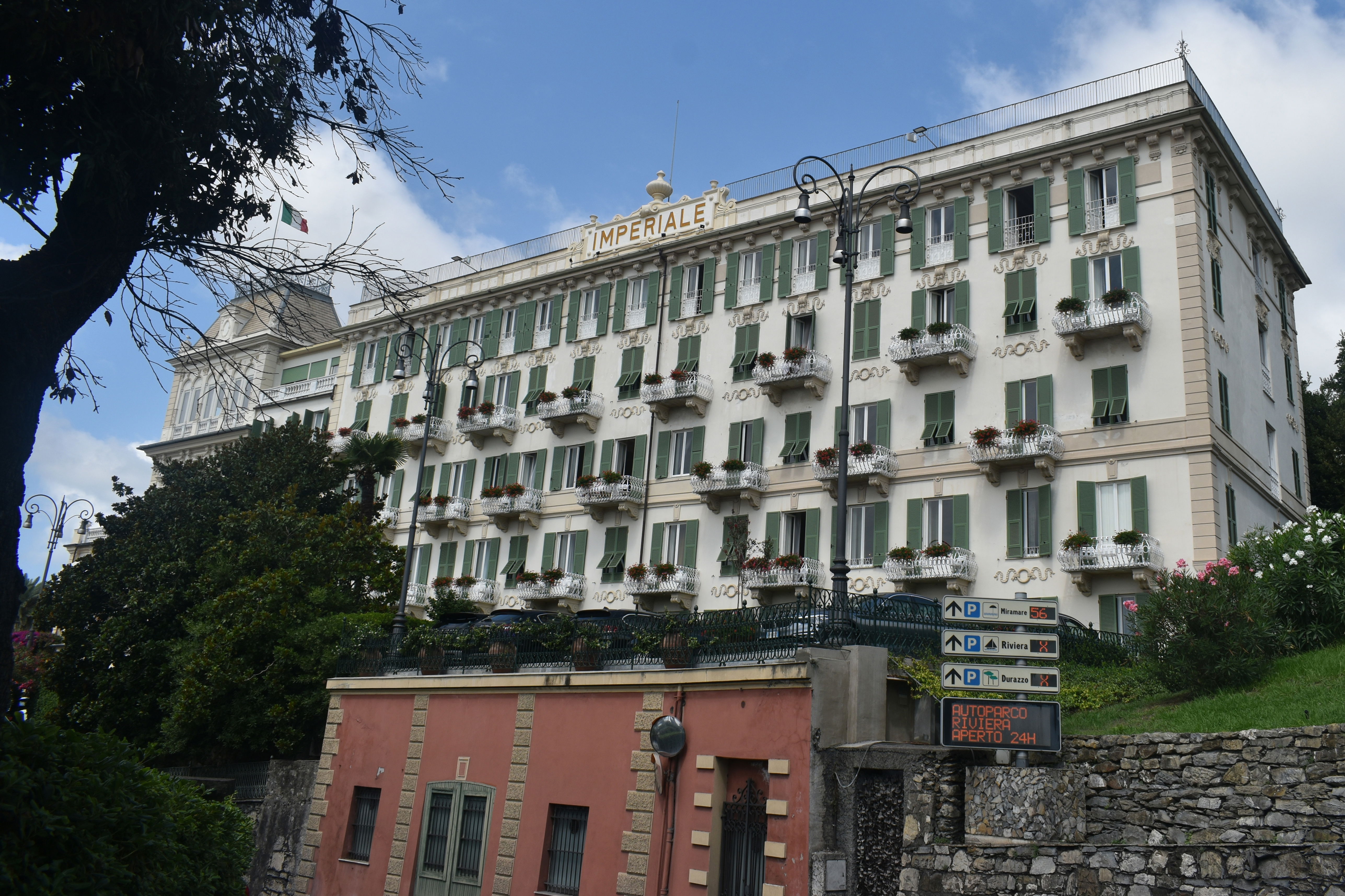
The Hotel Imperiale, Rapallo
The Hotel Imperiale was the base for the Soviet delegation to the Genoa Economic and Financial Conference which was held from 10 April to 19 May 1922. While most of the other delegations were housed in the hotels and palaces of Genoa, the Soviet delegation was for security reasons out in Santa Margherita. British journalist, John Saxon Mills reported that:
“The presence of the Bolshevik leaders presented a rather embarrassing problem, as their security outside the Russian frontiers might conceivably be precarious. They were lodged at Santa Margherita, near Rapallo. The railway line between that lovely spot and Genoa was guarded by numerous troops, and a ship of war lay at anchor in the adjoining bay. “
Also present in Genoa and covering the Conference for Toronto Star Weekly was a young Ernest Hemingway, who sent numerous dispatches. Hemingway had been contributing pieces to the Toronto Star Weekly since 1920, and the paper gave him his opportunity to report from Europe from where he started filing reports in February 1922.In April 1922, he headed down to Genoa to cover the conference, These included a description of the Soviet base at the Hotel Imperiale
“Italy’s first move to guard the Soviet representatives was to give them , as living quarters, the Imperial Hotel at Santa Marguerita. It has large, steeply walled grounds and the walls are so far from the hotel itself that it would take a Babe Ruth to chuck a bomb over. There is no doubt that the Imperial is a fine safe place but it is located so far from Genoa that at least four hours a day are wasted going to and from the various meetings”
The Italians had made it so difficult to get into and out of the Imperial, that Hemingway finally has to get hold of special pass, issued by an official of the Cheka, the original Soviet Secret Police. In another dispatch he returns to the difficulties of getting to the Imperial:
“Newspapermen in crowds make the long, all-day trip to Rapallo and Santa Marguerita. They either go in motorcars and are choked with dust or sit in dirty train that goes through some thirty tunnels as t follows the ocean shore. When they get to the Russia Headquarters at the Imperial Hotel at Santa Marguerita the chances are more than even that the Russians refuse to see them”

Another view of the Hotel Imperiale
It is still about a forty- or fifty-minute train ride from Genoa to Santa Margherita, although they do now have some smart new trains on the route. In the summer they are full of tourists, and the new trains don’t have adequate space for the luggage. We watched a narrowly avoided accident as the train braked and a very large trolley self-propelled itself from the upper deck down the stairs, narrowly missing the person below. Hemingway did not have to put up with that sort of thing.
The Genoa conference was planned by British Prime Minister David Lloyd George to resolve the major economic and political issues facing Europe after the first World War and to deal with the pariah states of Germany and the Soviet Union, both of which had been excluded from the Paris Peace Conference of 1919. Lloyd George told the British Parliament that the primary intent of the conference was to provide for the "reconstruction of economic Europe, devastated and broken into fragments by the desolating agency of war". The economy of Europe was at the point of collapse, as Lloyd George noted:
“If European countries had gathered together their mobile wealth accumulated by centuries of industry and thrift on to one pyramid and then set fire to it, the result could hardly have been more complete. “

The Palazzo San Giorgio, Genoa where the Plenary sessions of the 1922 Genoa Conference were held
Lloyd George sought the inclusion of Germany and Soviet Russia to the international conference as equal members, which was particularly opposed by France, who viewed any softening in the hard-line stance towards Germany was perceived by France as a weakening of the Treaty of Versailles. Germany was represented by Chancellor Joseph Wirth and Foreign Secretary Walter Rathenau and the Soviets by Tchitcherin, the Foreign Minister. John Saxon Mills described the arrangements in Genoa:
“Genoa had embellished herself in many ways. She had hung out everywhere her bright tricolor, and many a stately vista of street and square was thus enriched. Palaces, hotels, and villas, not only in Genoa but along the Ligurian Riviera, were prepared for the reception of the delegates. “
The British official headquarters were at the Hotel Miramare, “a splendid marble edifice commanding a wide view over Genoa and out on to the blue Mediterranean”. The Hotel Miramare is still there although no longer a luxury hotel. We visited Genoa on a rainy day and the massive bulk of the Miramare is one of the first things you see , heading out of the Piazza del Principe station towards the docks .Today it is being converted into apartments after having bee derelict for many years. Lloyd George and his ministerial colleagues and secretaries resided at the Villa de Albertis, an elegant mansion a few miles to the east. The other delegations were lodged in equal splendour and luxury in various places and hotels in Genoa, apart from the Russians as noted above.
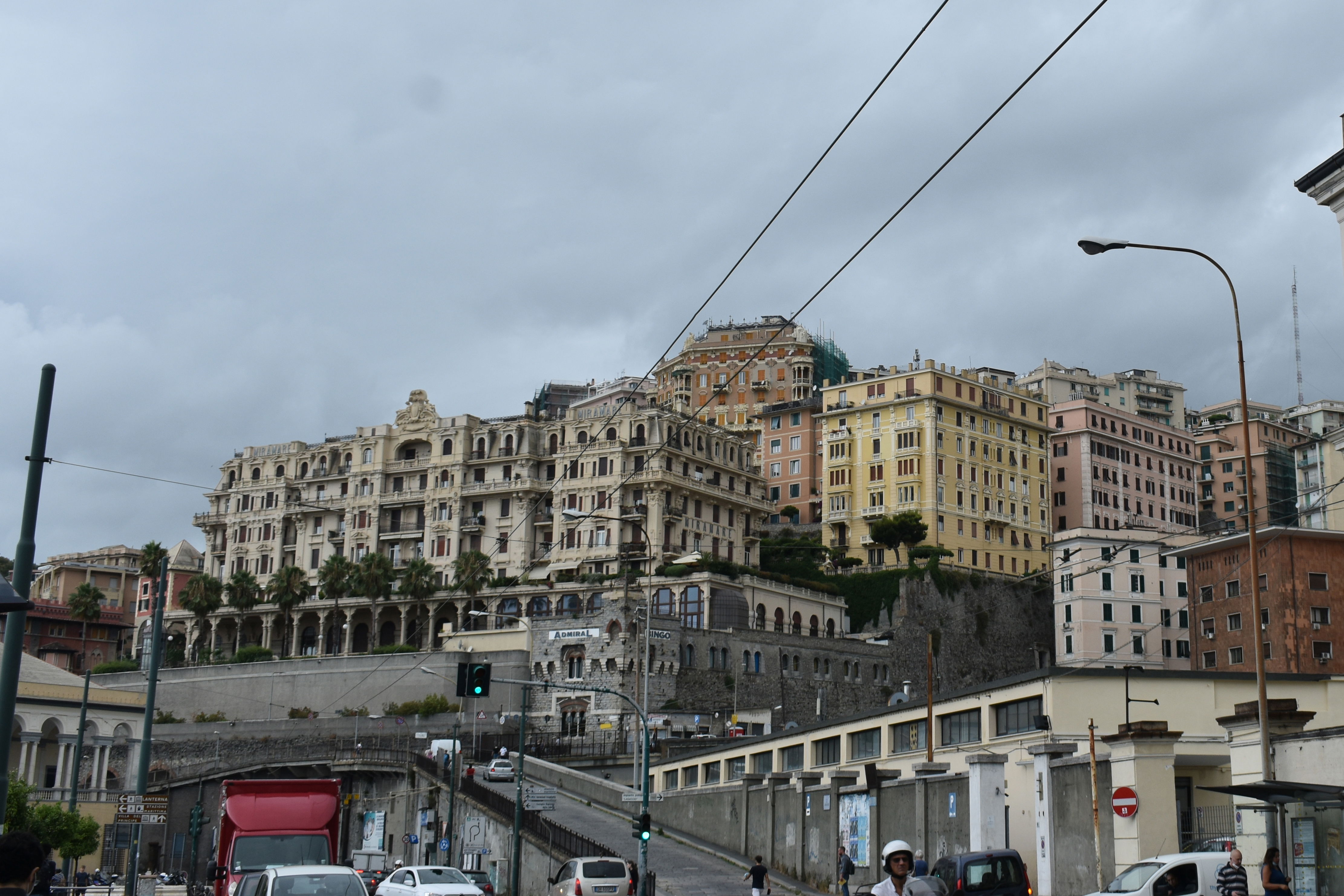
Hotel Miramare, Genoa where most of the British delegation were based for the Genoa Conference in 1922
No international conference would be complete without its program of entertainment and according to Saxon Mills:
“Dinners and receptions, concerts and excursions, festivities of all kinds, enlivened and even embarrassed the daily task of delegate and journalist. I have said that no city in the world is so richly equipped with the amenities for a stately and magnificent hospitality. The public receptions in various palaces were riots of regardless and indescribable splendour. One recalls particularly the soirees at the Palazzo Municipale and the Palazzo Ducale. The former communicated by broad, flower vased terraces with the equally opulent salons of the Palazzo Bianco, and through this dream of marble mosaic and glowing fresco, gold and scarlet furnishings and accumulated treasures of art, the thousand guests wandered at will —a simmering throng diversified with the steel and silver and red of military and ecclesiastical uniforms. "
Most eagerly awaited were the Russians arriving from their hideout in Rapallo and who seemed to be the stars of the show:
“The arrival of M. Tchitcherin and the other Russian delegates was awaited on such occasions with great interest. The chief delegate, having arrived at the gateway of the Palace, was hustled inside by a crowd of Genoese fellow-communists who crowded round him in order to intercept any explosives which might be going, though there was never much danger of that sort. Once inside, M. Tchitcherin was almost mobbed by an inquisitive, if not an admiring, throng who besieged him for autographs"
The Italian hosts did show off the charms of the Ligurian Coast, including Portofino. At least Mills enjoyed the trip.
“After a pleasant but clamorous luncheon some of us detached ourselves from the official party and walked by a winding cliff path through olive woods and fruit orchards along and down the cliffs to the little village of Portofino a Mare, or Porto San Giorgio, far below. This has been described as the loveliest spot in Europe. It is indeed almost freakishly beautiful. The coast of the Riviera di Levante here suddenly improvises a picturesque promontory which cuts off and protects a tiny harbour resembling a marble cup filled with sapphire water, round which the little village clusters.”
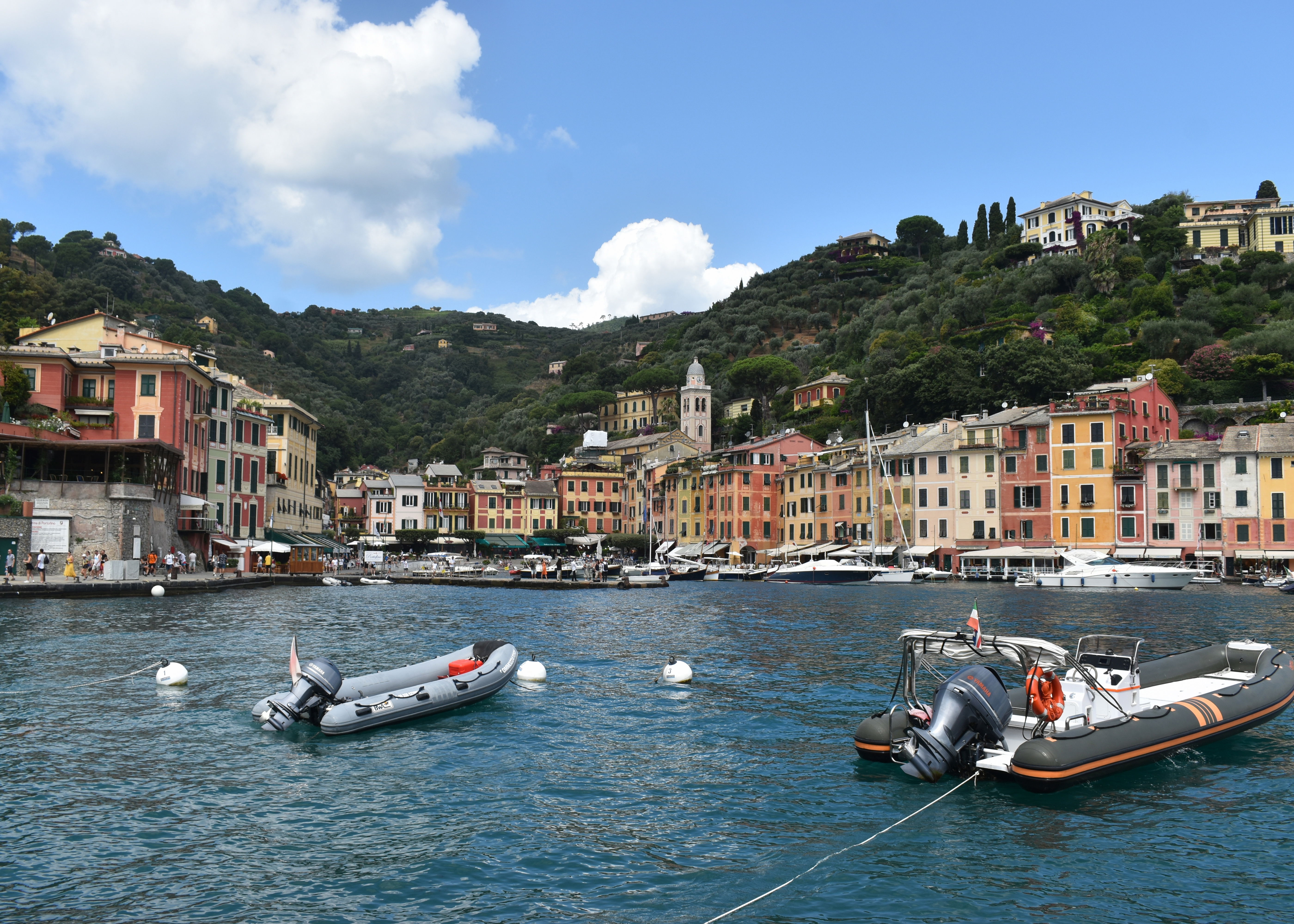
Portofino
While everybody else was enjoying the conference in Genoa, Wirth, Rathenau and Tchitcherin were holding secret negotiations at the Hotel Imperiale. Presumably, they weren’t that secret as the Hotel Imperiale was being so well guarded by the Italians, that thy probably knew who was coming and going. So it was not actually a great surprise, when the Germans and Soviets presented the conference with their fait accompli, in the form of the Treaty of Rapallo. The Treaty of Rapallo was signed at he Imperial Hotel on 16 April by Rathenau and Tchitcherin. Germany recognized the Bolshevik Government. Debts were reciprocally cancelled and Russia's claims for reparations from Germany under the Treaty of Versailles were waived : as also were German claims to all private property nationalized by the Bolsheviks unless the Bolsheviks should subsequently admit similar claims on the part of other States, in which case Germany was to enjoy most-favoured-nation treatment.

Walter Rathenau

Georgy Vasilyevich Chicherin ( Tchitcherin)- People's Commissar or Foreign Affairs
To the other conference attendees, the signing of the treaty seemed to have been chosen with the object of causing the maximum of provocation. The Russians maintained that it was purely fortuitous that the treaty had been signed at Genoa, and that they had begged the Germans to sign the treaty as they passed through Berlin early in April on their way to Genoa. The British were “surprised ad annoyed”, the French were apoplectic and threatened to walk out of the Conference. A distinction was made between Russia and Germany. The Russians were not parties to the Treaty of Versailles, with some articles of which the Russo-German instrument seemed to be irreconcilable. Russia was not yet a recognized and was at liberty to make any separate agreements she chose. So it was felt that, though Russia was not blameless, by far the greater blame fell on Germany. In their defence the Germans alleged that they had been excluded from confidential discussions with the Russians being held at the Villa de Albertis and that a separate arrangement was being mad which excluded them. So, in self-defence they had been obliged to complete a treaty which had been conference. He also affirmed that four or five Englishmen, including members of the British Delegation, had been to see him about Russia. He had kept them informed of the progress of the German negotiations with Russia, supposing that thev would inform the British Prime Minister. Rathenau added that Germany had been on the point of signing the treaty with Russia for several months, but refrained in the hope that a European federation might result from the Genoa Conference. Lloyd George insisted that the first he knew about the Treaty was when he heard it had been signed on the Monday afternoon. Despite all the controversy the Genoa Conference continued through to the Middle of May.
The participants in the Treaty of Rapallo met mixed fates On Saturday 24 June 1922, Walter Rathenau was being chauffeured from his house in Berlin-Grunewald to the Foreign Office in Wilhelmstrasse. During the trip, his NAG Convertible was passed by a car , a gunman opened at close range, killing Rathenau almost instantly It is tempting to think of how the fate of Europe might have been different if Rathenau had survived. Joseph Wirth was forced to leave Germany for exile in Switzerland. Somewhat surprisingly, Tchitcherin outlived, survived the Stalinist purges, and died of natural causes in 1936, although he had been somewhat sidelined by that time, nobody had murdered him.
The Italian Prime Minister. Luigi Facta was still Prime Minister on 27 October 1922, when he learned that the Fascists were marching on Rome, Facta had prepared the documentation for the King to sign declaring a state of siege. For some reason, and Facta never revealed why, the King never signed the State of Siege, and Facta’s government resigned. The next day the King to telegraphed Mussolini in Milan and ask him to come down to Rome and form a new government.
The Treaty of Rapallo 1920
Over the road from the Imperial Hotel, is the “Villa of the Treaty” . This smaller English style villa formed part of the estate of the Villa Spinola, which now belongs to the Sovereign Order of Malta. It was in the English redbrick villa that negotiations were carried on for the 1920 Treaty of Rapallo between Italy and Yugoslavia.
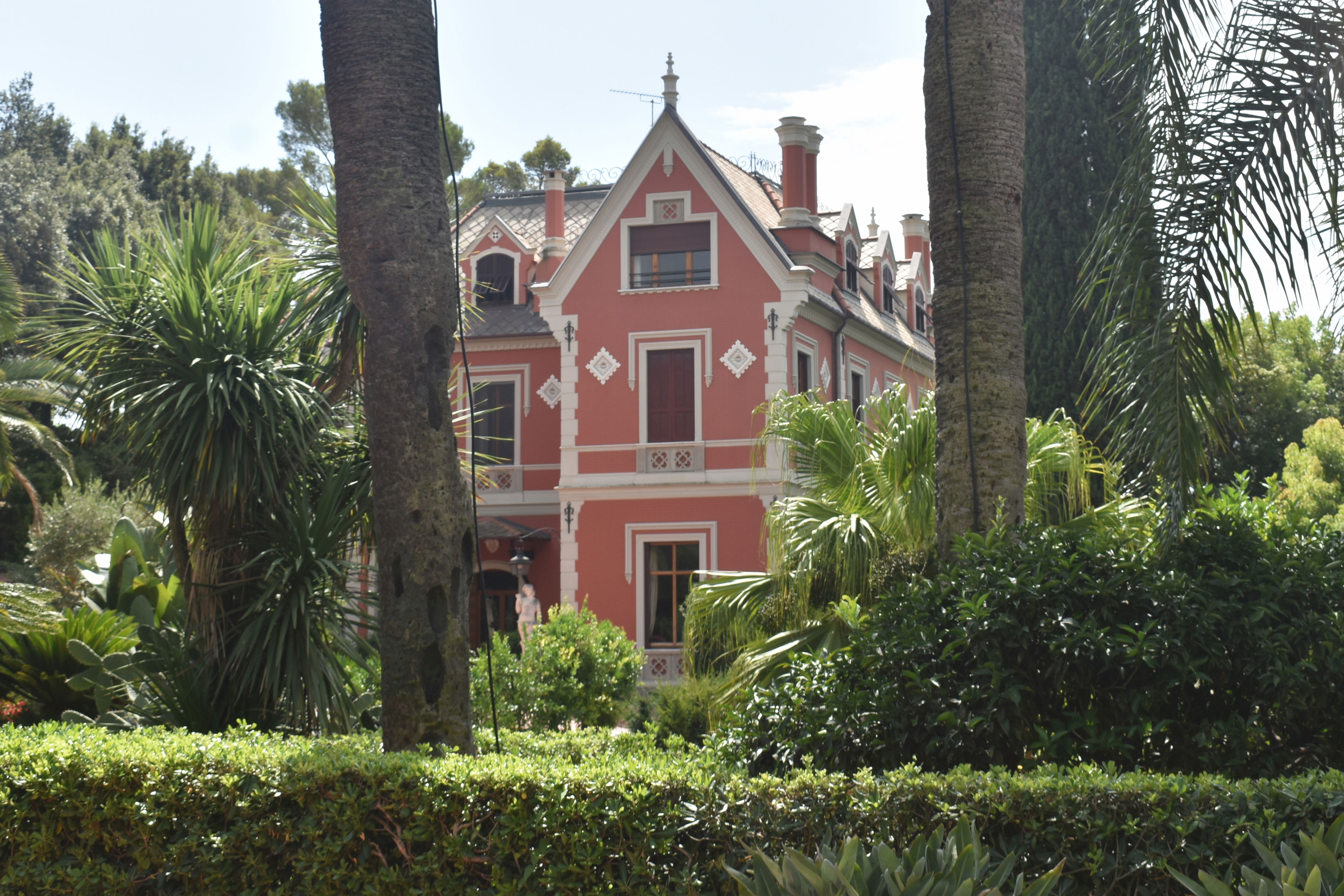
The Villa of the Treaty ( the 1920 one)
The Italians had entered the First World War based on the Treaty of London in 1915, and especially the secret clauses which agreed that in the event of an Allied Victory, they would make substantial territorial gains from the Austro- Hungarian Empire- especially the Austrian Littoral. When the Treaty of London was abrogated at Versailles, the Italians were forced to enter their own negotiations with the new Kingdom of Yugoslavia.
Negotiations were led by Ivanoe Bonomi, and Francesco Salata for the Italians. The Treaty was eventually signed by Giovanni Giollitti as Prime Minister of Italy and Milenko Vesnicas Prime Minister of Yugoslavia, also involved in the negotiations were Pietro Badoglio (of later notoriety) and Carlo Sforza (Foreign Minister). The Italian delegation stayed at the New Kursaal in Rapallo. For the Yugoslavs, the other participants were Kosta Stojanovic (Minister of Finance), Ante Trumbic (Minister of Foreign Affairs), General Danilo Kalafatovic and Mr. Antonijevic (Ambassador of Yugoslavia at Rome). The Yugoslavs stayed in the Hotel Imperiale. At the conclusions of the discussions, the following territories were annexed to Italy:
- The western parts of the former Duchy of Carniola:
- Most of the former Austrian Littoral
- The former Dalmatian capital city of Zadar
- According to the treaty, the city of Rijeka (Fiume) would become the independent Free State of Fiume, which ended the military occupation of Gabriele d'Annunzio's troops that had begun by the Impresa di Fiume. That part of the treaty was revoked in 1924, when Italy and Yugoslavia signed the Treaty of Rome, which gave Fiume to Italy and the adjacent port of Sušak to Yugoslavia
The treaty left a large number of Slovenes and Croats in Italy. According to the 1910 Austrian census, 480,000 South Slavs (Slovenes and Croats) became citizens of the Kingdom of Italy, and around 15,000 Italians became citizens of the new Yugoslav state (around 13,000 in Dalmatia and the rest in the island of Krk.
In the end that Treaty didn’t finish well for the Italians after the joining the Germans in invading Yugoslavia, the Italians finished up losing much of that they had gained at Rapallo at the cost of a massive exodus of the Italian population, well those who had not been killed by the Yugoslavs first. Fiume definitively became Rijeka and was lost to the Italians forever
After the Imperiale and the Villa of the Treaty the road heads down into Santa Margherita, and from there you can head he 5 or 6 km along the charming costal path to Portofino to admire the rather lovely village and take a break from war, peace an international diplomacy.
Sources and further information
Ernest Hemingway
Dateline Toronto
Amazon.co.uk : dateline toronto
Lloyd George Memoirs .https://archive.org/details/warmemoirsofdavi00lloy_2/page/558/mode/2up?q=Rapallo
The Genoa Conference https://archive.org/details/genoaconference00milluoft/page/368/mode/2upth
The Hotels
Sito Ufficiale Imperiale Palace Hotel - Prenota al miglior prezzo